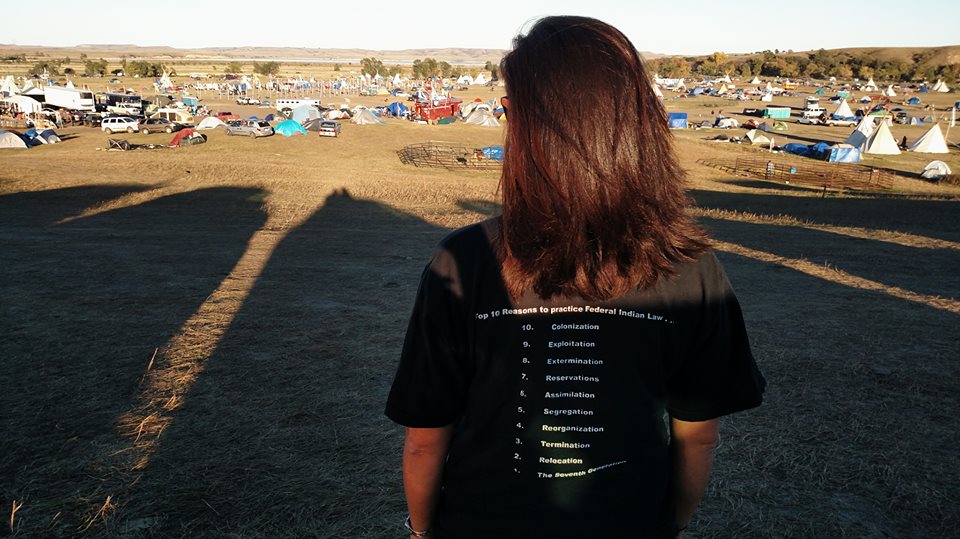It’s been painful for many of us in the Sierra Club community to live in this nation at a time when open, organized white supremacy and nationalism are growing and entering the mainstream. But there’s one particular pain I’ve been sitting with lately that is specific to my own family and traditions.
I never would have guessed the swastika would be part of everyday life in the U.S. in 2017 - but here we are. Everywhere I look, this symbol is being used to inspire fear and intimidate people with marginalized identities.
But the ancient symbol now known as a swastika meant something very different for my people before it was appropriated by Nazis. For many cultures, this image has been a symbol of peace and prosperity for thousands of years
My people, the Diné, called this symbol the “whirling log” and used it in sand painting rituals meant for healing. I have heard stories from family members about how the history of this symbol dates back for generations before us, found in artifacts, weavings and pottery and sand paintings. According to the U.S. Holocaust Memorial Museum, “the word swastika comes from the Sanskrit svastika, which means “good fortune” or ‘well-being.’” It has been used by cultures across the world for at least 15,000 years.
As a Native woman living in the U.S., my culture is often appropriated. Sometimes folks struggle to understand why that is so painful for me. I’ve heard it argued that imitation is the sincerest form of flattery, and Native folks shouldn’t be so sensitive. But it’s not flattering to see my culture exoticized or turned into a bad joke. As incredible Native activist and my dear friend La Donna Brave Bull Allard put it: "Everything has a meaning and so it is not a costume. It is our lives. What is culture? It is the way we live, it is our lives. And when you take our lives, you make it something to be made fun of, something to play with, something that clowns do. You disrespect my whole culture and my whole people."
As a Native woman living in the U.S., my culture is often appropriated. Sometimes folks struggle to understand why that is so painful for me.
The theft of the swastika is perhaps the clearest example of how cultural appropriation is a form of violence against a culture. For 15,000 years, disconnected cultures around the world celebrated this symbol. But when one single movement of violence and hatred claimed it as their own, as the legacy of their manufactured “Aryan” identity, it was tainted and lost forever.
This theft became official in 1940 when the Navajo, Papago, Apache and Hopi people signed a historically unique proclamation rejecting a piece of their own cultural identity because of the Nazis. The proclamation read, "Because the above ornament, which has been a symbol of friendship among our forefathers for many centuries, has been desecrated recently by another nation of peoples, therefore it is resolved that henceforth from this date on and forever more our tribes renounce the use of the emblem commonly known today as the swastika . . . on our blankets, baskets, art objects, sand paintings and clothing."
We were forced to give up a sacred symbol because it had been stolen from us by people who sought to destroy us. This is just one of many sacrifices my people made during World War II. Over 25,000 Native Americans fought in World War II; some tribes sent up to 70 percent of their able-bodied population off to war. When the Navajo Code Talkers, instrumental to U.S. military success in the war, returned home, they learned that in many states they were not even eligible to vote, much less access the many benefits of the GI Bill
Some Native peoples have attempted to reclaim the symbol as the whirling log. But as organized white supremacists continue to grow in power and influence around the world, the day that we can reclaim this symbol feels farther and farther away.
It’s very possible to learn about and celebrate Native traditions and culture without appropriation. Begin by learning about the Native peoples whose homeland you reside in. When Columbus Day rolls around, choose to celebrate Indigenous People’s Day rather than honoring a mass murderer. If you love Native culture and want to display Native art in your home, or give it as a gift, support Native artisans by buying directly from them.
Finally, if you’re worried that your own personal style or costume choices cross the line into cultural appropriation -- it just might. While you’re planning your Halloween costume, learn to practice objective self-assessment and check out this video from Franchesca Ramsey on how to navigate this tricky topic.
